Botox Injections for TMJ (Temporomandibular Joint)
Jaw tension caused by teeth grinding, over-active masseter muscles, or jaw clenching due to stress can lead to severe pain and discomfort along the jaw, called the temporomandibular joint, or TMJ, and beyond. So many of us have bitten into something sticky, chewed gum, or chatted with a friend when suddenly we feel a clicking, popping, or painful sensation along the jaw joint. Our jaw muscles are some of the most active facial muscles, operating regularly during the day and often storing tension at night. Unfortunately, this activity can lead to misalignment, stress, and pain along the temporomandibular joint. Characterized by jaw pain, aches around your ear, chronic migraines, and jaw dysfunction that can lead to difficulty chewing and opening or closing the mouth, TMJ disorders can feel like they are keeping you from your highest quality of life. While pain or soreness around the jaw joint and lower jaw do not suggest serious issues for everyone, patients may develop more serious temporomandibular joint disorders, abbreviated as TMDs, which can suggest chronic facial pain. Luckily, TMD treatment options are available at Dr. Green’s private dermatology in NYC, including the use of Botox injections.
Botulinum toxin, known colloquially as Botox, is an injectable treatment that essentially “freezes” the muscle at and near the injection site. While many patients may hear “Botox” and think about cosmetic treatments to eliminate frown lines and other facial wrinkles, Botox has been FDA-approved to treat many medical conditions, including chronic migraines, blepharospasm, and cervical dystonia. As TMJ disorders are caused by overuse or pain in the masseter muscle of the jaw, the use of Botox acts as a muscle relaxant, which alleviates the tension along the jawline to eliminate symptoms of TMD, including headaches, lockjaw, and jaw pain. If you suffer from jaw pain and soreness, tension headaches, or other frustrating TMJ symptoms, Botox injections in the masseter muscles can provide you with the relief you have been looking for. Botox for TMJ is a common off-label use of Botox that an experienced dermatologist can administer.
New York-based, board-certified cosmetic dermatologist Dr. Michele Green is an expert in the use of Botox, including Botox injections to relieve TMJ symptoms and reduce the masseter muscle for facial slimming. Dr. Michele Green is an Allergan Platinum injector of Botox, utilizing Botox extensively to treat fine lines around the forehead, neck, crow’s feet, lips, and glabella area for facial rejuvenation. Dr. Green embraces a less-is-more philosophy and takes a holistic approach to treatment, customizing each patient’s treatment plan to cater best to their particular concerns and overall aesthetic goals. She is consistently identified as one of NYC’s best dermatologists by Castle Connolly, New York Magazine, and Super Doctors for her dedication to her patients and expertise. When you consult with Dr. Green at her private dermatology office in the Upper East Side neighborhood of Manhattan, she will work with you to develop a customized Botox treatment plan that leaves you looking and feeling like your best self.
What is TMJ?
The Temporomandibular joint, or TMJ, is where the jaw bone (mandible) connects to the skull (temporal bone), essentially operating like a sliding hinge on either side of the face. The connecting parts of the bones have a cartilage covering and are separated by a small disk designed to be shock-absorbent and keep jaw movements as smooth as possible.Many patients feel jaw pain or discomfort along this joint. Years of clenching your teeth in waking hours and while you sleep induce an overactive masseter muscle that grows larger and more uncomfortable over time. This jaw tension especially affects patients during sleep, as it causes teeth grinding that can ultimately damage them. Research by the National Institute of Dental and Craniofacial Research has estimated that more than 10 million Americans suffer from TMJ issues and have associated tension headaches, pain, tension, clicking, and grinding. Botox treatment in the masseter muscle to relieve TMJ has become a simple, fast, and effective way to treat bruxism (teeth grinding).
What Causes TMJ Disorder (TMD)?
Due to the strength of the muscles along the temporomandibular joint, temporomandibular joint disorder, known as TMD, is a quite common condition. TMD/TMJ is largely caused by jaw clenching, though many people who clench their jaws will never experience the burning pain and swelling that can occur with TMD. TMJ disorders can also be prompted by injury to the jaw, head, or neck muscles, such as from a heavy blow or impact from the body. Additionally, pain from TMJ can be due to genetic factors or arthritis, as well as when the disk erodes or shifts from its proper alignment.
TMD/TMJ Symptoms
Symptoms of temporomandibular joint disorder (TMD)/TMJ include:
- Jaw pain/ soreness
- Jaw clicking or popping
- Facial pain behind the eyes, neck, or shoulders
- Ringing in the ears
- Headaches ranging from mild, dull aches to chronic migraines
Typically, those who experience symptoms of Temporomandibular joint disorders such as bruxism experience symptoms cyclically. The pain can go away independently or with minimal treatments (such as anti-inflammatories or alternating heating pads and cold packs along the jaw). However, returning TMJ symptoms or longer-term symptoms often cause enough pain to seek medical or dental treatment.
In the past, those suffering from TMJ pain have looked to mouth guards, bite guards, or stabilization splints to improve jaw tension while sleeping, prevent damage to the tooth enamel, and promote oral health. Sometimes, pain is so severe–from swollen jaw muscles to chronic migraines–that patients will experiment with “no-chew” diets, cognitive behavioral therapy, physical therapy, or surgical intervention. Often, these TMJ treatments can lead to inconsistent results, leading to the development of alternative treatments. Botox injections along the jaw are an innovative way to limit, reduce, and sometimes eliminate TMJ/TMD symptoms.
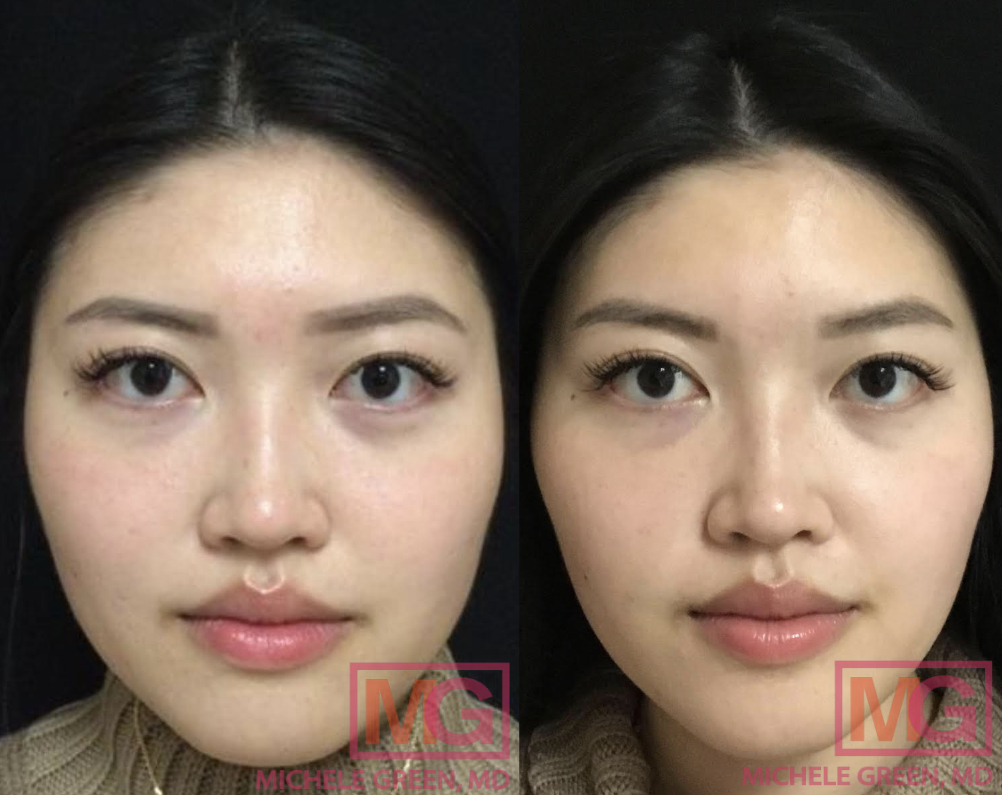
Before and after 1 treatment of Botox to the Masseter muscle area
What is Botox?
Botulinum Toxin Type A, better known as the popular brand name Botox, is an injectable treatment produced by the pharmaceutical company Allergan. Botox is a neurotoxin derived from the Clostridium botulinum bacterium. While it is widely recognized as the gold standard for reducing dynamic fine lines and wrinkles, Botox has many cosmetic and medical applications. Botox has been FDA-approved for cosmetic purposes to reduce the appearance of fine lines and wrinkles around the eyes and across the forehead and treat certain medical conditions, including chronic migraines and muscle spasms.
Once injected, the injectable neurotoxin causes controlled, targeted muscle paralysis in the treatment area. The neurotoxin inhibits specific nerve signals that control facial expressions, limiting the movement of particular facial muscles and ultimately “freezing” them. Freezing the muscles causes them to relax, smoothing fine lines and wrinkles and relieving pain or spasms caused by overactive muscles. The effects of Botox remain for approximately four months, with most patients engaging in regular maintenance treatment sessions to uphold the best results. There is essentially zero downtime associated with Botox treatment and few potential side effects. The most common side effects include mild swelling and redness at the injection sites, which resolve independently shortly following treatment.
Does Botox treatment help TMJ?
Botox (botulinum toxin) is a neurotoxin-based injectable cosmetic treatment that “freezes” facial muscles on and around an injection site, designed to relax the muscles and alleviate overuse. Though it’s more commonly used in the United States to treat crow’s feet and forehead wrinkles, Botox has been used in Asia for years to slim the face and facial muscles by injecting it directly into the masseter muscle. Many patients seek injections of the masseter muscle to have a more elongated, slimmer face. It turns out that this treatment has an incredibly positive side effect: by injecting Botox directly into this hypertrophic (overactive) muscle, its function decreases, which then diminishes the symptoms of common TMJ disorders. Over time, with repeat Botox injections at 3 to 5-month intervals, the masseter muscle decreases in size, allowing the TMJ joint to relax and the symptoms to resolve.
Botox for TMJ is generally injected directly into the masseter muscle and, occasionally, other jaw muscles, such as the temporalis and frontalis muscles. No pain, bruising, or downtime is associated with these TMJ injections. Dr. Green recommends that these Botox injections be repeated periodically to maintain the desired effect. Your symptoms will resolve with the continued weakening of the muscle through these Botox injections.
Does Botox help jaw clenching?
As jaw clenching is a common cause of TMJ/TMD pain, it follows that Botox injections can be used to treat jaw pain from clenching. TMJ Botox can target the facial muscles responsible for jaw clenching, such as the larger masseter muscle along the jaw, thus reducing the overactivity of the muscles over time. When Botox is injected into the masseter muscle, the muscle relaxes, and the neurotoxin in Botox also prevents the muscle from involuntarily contracting, preventing jaw clenching.
How is Botox an effective TMJ treatment?
Botox treatment involves the injection of the neurotoxin botulinum toxin type A into certain facial muscles to “freeze” and relax them. TMJ disorders are frequently caused by strain or overuse of the masseter muscles in the jaw. Jaw clenching, teeth grinding, and overworking the masseter or jaw muscles can lead to tension and pain throughout the jawline and around the face. When treating TMD, Botox is injected directly into the masseter muscles. Once injected, the botulinum toxin blocks the neurotransmitters that tell the masseter muscles to contract involuntarily or in excess. This relaxes the masseter muscles, relieving tension, providing pain relief, and eliminating involuntary clenching of the jaw from stress or grinding teeth in your sleep. This makes Botox an extremely effective treatment for TMJ disorders.
Botox injections for TMD are still an off-label use for Botox, meaning that Botox is not specifically approved to treat TMJ disorders. However, several studies have demonstrated that Botox is safe and effective for treating TMD. According to a study performed in 2012, when treating TMD, Botox was shown to alleviate jaw pain and increase the movement capacity of the jaw for up to three months after the injectable treatment was performed. In 2003, a study demonstrated that 90 percent of patients who had not responded to other treatments showed improvement after receiving Botox treatment. While more research is being done to have Botox FDA-approved to treat TMD, the studies demonstrate that the treatment is very effective and can be easily performed by a board-certified dermatologist, such as Dr. Green, for amazing results that last several months.
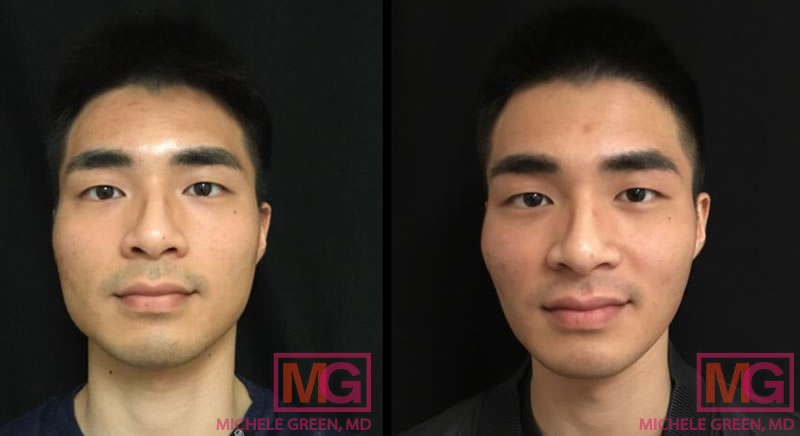
Botox to masseter area – 3 months
Botox Injections for Relieving TMJ Pain
In addition to TMJ Botox, Dr. Michele Green recommends limiting the amount of chewing gum or sticky candy you chew. Since the masseter muscle is one of the muscles activated during chewing, limiting excess chewing can help to relieve jaw tension, thus alleviating TMJ pain. Dr. Green also recommends dental night guards, as continual use prevents unintentional teeth grinding and clenching of your jaw at night, thus limiting TMJ/TMD symptoms and damage to your teeth. Many patients have a functional impairment, pain, spasms, lockjaw, headaches, or difficulty chewing. They don’t realize these are TMJ symptoms, which can be easily and successfully resolved with Botox treatment. Dr. Green can help you work through these symptoms and resolve your pain through Botox injections and other TMJ treatments.
The Botox treatment Process for TMJ
The process for treating TMJ with Dr. Green is very straightforward. Dr. Green will examine your jaw, masseter muscles, and dental configuration during your initial consultation. She will determine if Botox is the proper treatment to relieve your TMJ symptoms or to achieve facial slimming. Your TMJ Botox treatment may be performed on the same day as your consultation, depending on the time allowance and your preference. When you arrive at the NYC office for the treatment, photographs are taken before the procedure for your private medical records. Then, Dr. Green will mark the injection area to indicate where the Botox injections will occur. The number of injections will vary from patient to patient and will depend on the size of the masseter muscle and the areas of the face that are most affected by the TMJ pain. Most patients feel little to no discomfort with Dr. Green’s practiced hand during the Botox injection process. The final effects of Botox take up to two weeks to develop. Two to four weeks after your Botox injections, you will return to the office for examination and additional photography to ensure complete treatment of the area. Additional suggestions, such as night guards and other modifications, may be added at that time.
What to expect after Botox for TMJ
Botox treatment is a safe and effective treatment for TMJ that requires no downtime following the procedure. Patients may experience some minor side effects in the days following treatment, such as swelling, bruising, redness, and soreness at the injection site. Still, these side effects will resolve themselves on their own within a couple of days of receiving the treatment. Dr. Green recommends avoiding rubbing or massaging the treatment area to prevent the botulinum toxin from spreading to other areas. Patients can expect to see the full results of the treatment approximately two weeks after the procedure, and the effects of Botox treatment usually last for 3-4 months.
Where is Botox injected for TMJ treatment?
Botox injections for TMJ are performed most commonly in the masseter muscles but may also be injected in the temporalis area. The number of injections and area of treatment depends on several factors, including the size of the masseter muscle and the areas of pain. When you have your initial consultation with Dr. Green, she will assess the treatment area, and you will discuss the nature of the pain you are experiencing to determine where and how many injections are needed to treat your condition properly.
Does Botox for TMJ change face shape?
When your masseter muscles are overused, hypertrophy or enlargement occurs. The masseter muscles in your jaw are similar to other muscles in your body in that the more they are engaged, the bigger and stronger they can develop. When masseter hypertrophy occurs, it can result in a large, wide, square-shaped, more muscular-appearing jaw. When Botox is injected into the masseter muscles, it can cause the facial muscles to weaken, which produces a more narrow jawline, which many patients find aesthetically desirable. Overworked masseter muscles can cause the lower face to develop a boxy appearance, known as a square jawline. When Botox is injected into the masseter muscle, it prevents the muscle from overexerting. This eventually causes the muscle to become smaller, reducing the squareness of the jaw. The result is a slimmer face and a more V-shaped jawline. Depending on the initial size of the jaw muscles, multiple subsequent Botox treatment sessions may be required to achieve facial slimming effects. For more information on this process, see our page, Non-Surgical Jaw Reduction.
Is Botox Jaw Reduction Permanent?
Botox is an injectable neurotoxin that produces long-lasting but temporary effects. However, patients can successfully achieve permanent TMJ relief and jaw muscle reduction with regular maintenance Botox treatment sessions. The effects of Botox for TMD and facial slimming are generally long-lasting after several subsequent treatment sessions. Depending on the initial size of the jaw muscle, several Botox treatments may be required before ideal results are achieved. With each subsequent treatment of Botox injections in the masseter muscle, the muscle gets smaller, TMJ relief lasts longer, and the cosmetic results of facial slimming continue to improve. The effects of Botox can take up to two weeks to kick in after the injections and tend to last up to four months. Dr. Green will happily work with you to find the best treatment plan for your specific needs.
How Much Botox is Needed for Jaw Reduction?
In addition to relieving TMJ symptoms, Botox injections in the jaw muscle can be used to reduce the size of the muscle and achieve a cosmetic facial slimming effect. Dr. Green evaluates each patient individually to determine the number of units of Botox required to reduce the size of the jaw muscle effectively. On average, 50 units of Botox are injected (25 units on each side) as the preliminary dosage. All patients are brought back to Dr. Green’s office two weeks after their initial Botox injections to ensure the masseter muscle is frozen and to determine if additional Botox is needed in the area.
How many units of Botox for TMJ?
When patients ask how many units of Botox are needed for TMJ, the answer is that it depends. Several factors go into determining the number of units necessary, including the size of the masseter muscle, the severity of the muscle tension, and the patient’s individual face shape. When you have your initial consultation with Dr. Green, she will examine the treatment area and be able to provide you with a more accurate estimate of the number of Botox units necessary to address your specific needs. Botox injections will be necessary for the masseter muscle and sometimes the forehead and temple to fully address the pain from TMJ disorders.
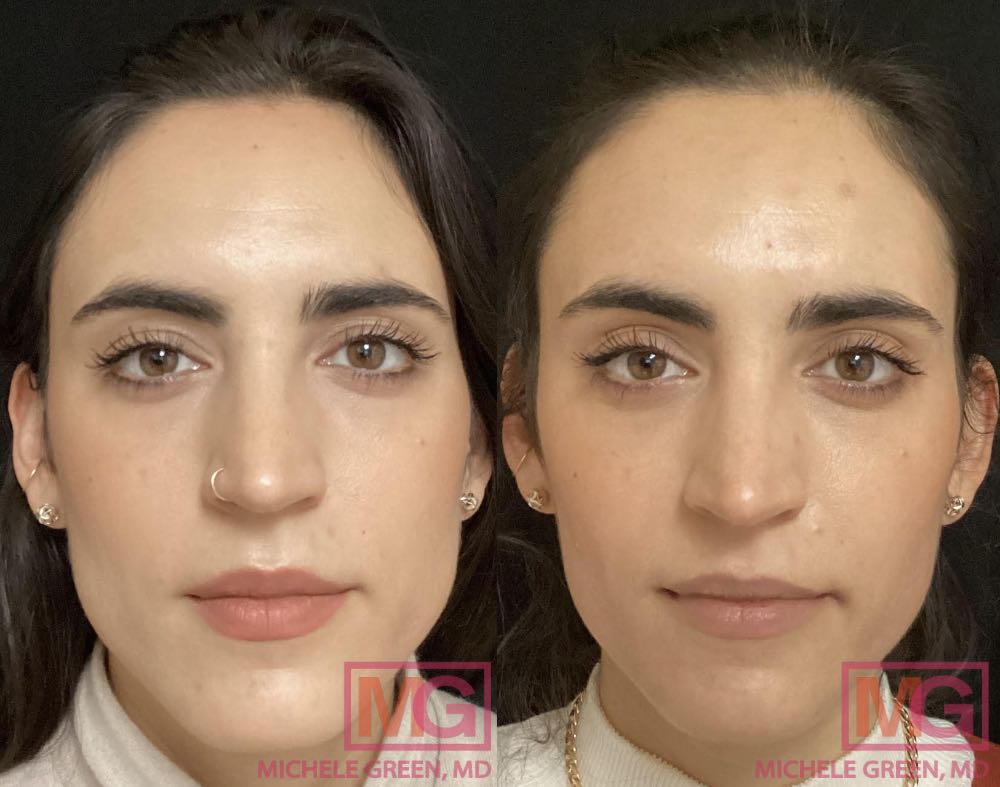
How many units of Botox are needed for jaw clenching?
The number of units of Botox necessary to treat jaw clenching depends on several factors specific to each individual patient. Botox injections are an excellent solution for treating jaw clenching, as they work to relax the masseter muscle responsible for bruxism. The Botox essentially “freezes” the jaw muscle, preventing it from contracting involuntarily or excessively. Usually, when injecting Botox into the jaw, Dr. Green may start with between 20 and 30 units of Botox on each side. The exact number of units of Botox needed depends on the masseter muscle size and the patient’s face shape. To treat the underlying causes of jaw clenching, Dr. Green may also inject Botox into the forehead and temple to relax the facial muscles there, which may be an additional 15-25 units of Botox. The best way to determine how many units of Botox are needed to treat your clenching is by consulting Dr. Green at her private dermatology office in Manhattan’s Upper East Side neighborhood.
How much does Botox for TMJ cost?
The cost of your TMJ Botox can vary depending on a range of factors, including the geographic location of the office where you’re treated, the experience level of your injector, and the amount of Botox required. Botox treatment may be priced per treatment area or by units of Botox used. The number of units of Botox needed to treat TMJ successfully varies from person to person, depending on the size and strength of their jaw muscles. Following your initial consultation with Dr. Green, her office will be able to provide you with an estimate of the cost of your TMJ Botox. Botox treatment with an experienced board-certified dermatologist like Dr. Green may be more expensive than a med spa or clinic with a nurse injector. However, the risks of side effects are reduced by consulting an experienced, board certified physician for your Botox injections.
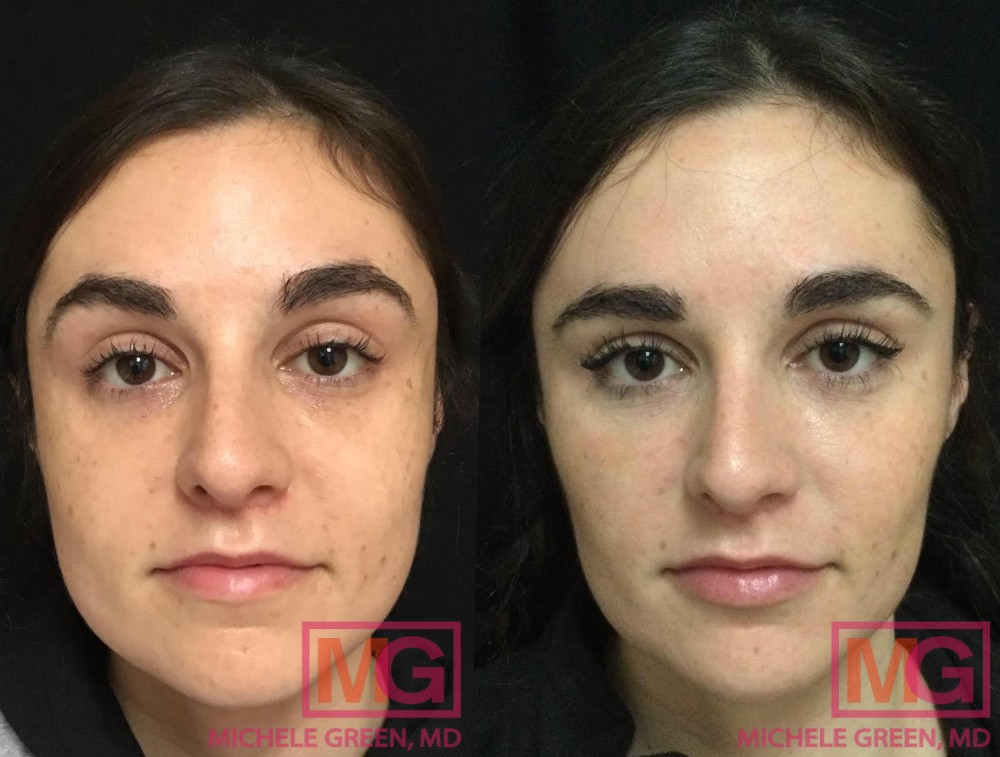
Is botox for TMJ FDA-approved?
While botulinum toxin injections are FDA-approved for many muscular disorders, Botox for TMJ is an off-label treatment and not FDA-approved. As such, Botox treatment for TMJ is not yet recognized as an official medical treatment, so insurance companies will not typically cover this procedure.
Does health/medical/dental insurance cover Botox for TMJ?
If you are wondering about coverage for Botox to treat TMJ disorders, it is best to contact your insurance company directly to ascertain coverage. They can inform you about what your plan does and does not cover, including Botox treatment options. Most insurance companies do not cover Botox injections for TMD/TMJ. Will Botox treatment help TMJ?
Do Botox Injections really work for TMJ?
Yes! TMJ disorders are often caused by overuse of the masseter muscles from excessive chewing, stress clenching your jaw, or grinding your teeth at night. Botox effectively eliminates pain from TMJ by weakening the masseter muscle. When this occurs, the jaw muscle will no longer contract excessively or involuntarily, reducing the jaw’s tension. Botox is one of many potential treatment options for TMJ disorders, and for the treatment to be most effective, Dr. Green may recommend pairing Botox with other treatments.
Within the realm of dentistry, the accessibility of products such as Orals pints, mouth guards, or Invisalign are very appealing and can help if TMJ pain is caused by teeth grinding or bruxism at night; however, while these help to alleviate the symptoms, they do not address the cause of the pain. If TMJ disorders stem from stress and anxiety, muscle relaxants, physical therapy, acupuncture, or relaxation techniques may help address the issue. There are also surgical procedures such as arthroscopy or arthrocentesis, which are minimally invasive surgical procedures. When you consult with board-certified dermatologist Dr. Green, she will develop a customized treatment plan for your TMJ Botox and your specific needs.
Are there any side effects associated with TMJ Botox? What is the downside of Botox for TMJ?
When an expert board-certified dermatologist, such as Dr. Green in NYC, performs your Botox treatment, there are few side effects. Botox injections’ most common side effects are mild swelling, redness, or bruising at or near the injection sites. These side effects typically resolve independently shortly following treatment. The procedure is painless, as Botox injections do not cause discomfort in this area. Patients do not need to use a topical numbing cream in the treatment area to prepare for this procedure.
It is important to note that, though research on Botox treatments for TMJ has been positive, this alternative treatment has not yet been approved by the United States Food and Drug Administration (FDA), meaning that it’s an “off-label use” for Botox injections. It is important to consult an experienced board-certified dermatologist, like Dr. Michele Green in NYC, for your Botox injections TMJ treatments. Dr. Green is a master cosmetic Botox injector, including the use of Botox for TMJ treatment and facial slimming.
Can Botox make TMJ worse?
TMJ Botox injections help relieve pain, soreness, and tension in the jaw. Botox treatment can also help reduce TMJ symptoms like clenching and grinding, ultimately preventing future damage to the jaw joint. Jaw pain is typically not reported after Botox injections. Botox injections can have mild, common side effects, including redness, bruising, swelling at and around the injection site, and muscle weakness. A simple cold pack should resolve any discomfort post-procedure. Botox is a very safe and effective treatment for TMJ disorders, and your risk of developing any more serious side effects is greatly reduced if you seek treatment from an expert, board-certified dermatologist, such as Dr. Green.
How long does TMJ Botox last?
Botox is an injectable neurotoxin that often lasts for 3-4 months, depending on the individual and the depth of their jaw pain. Multiple subsequent treatment sessions may be required to achieve facial slimming effects from TMJ Botox and to maintain pain relief, depending on the severity of symptoms and initial strength of the jaw muscles. Botox treatment is only temporary, and most patients need to have a regular maintenance treatment session every three to four months, depending on their natural metabolic process. Maintaining a regular treatment schedule for Botox injections is the best way to get continued symptom relief. When you consult with Dr. Green at her NYC dermatology office, she will work with you to create a treatment plan for your Botox injections that best suits your needs.
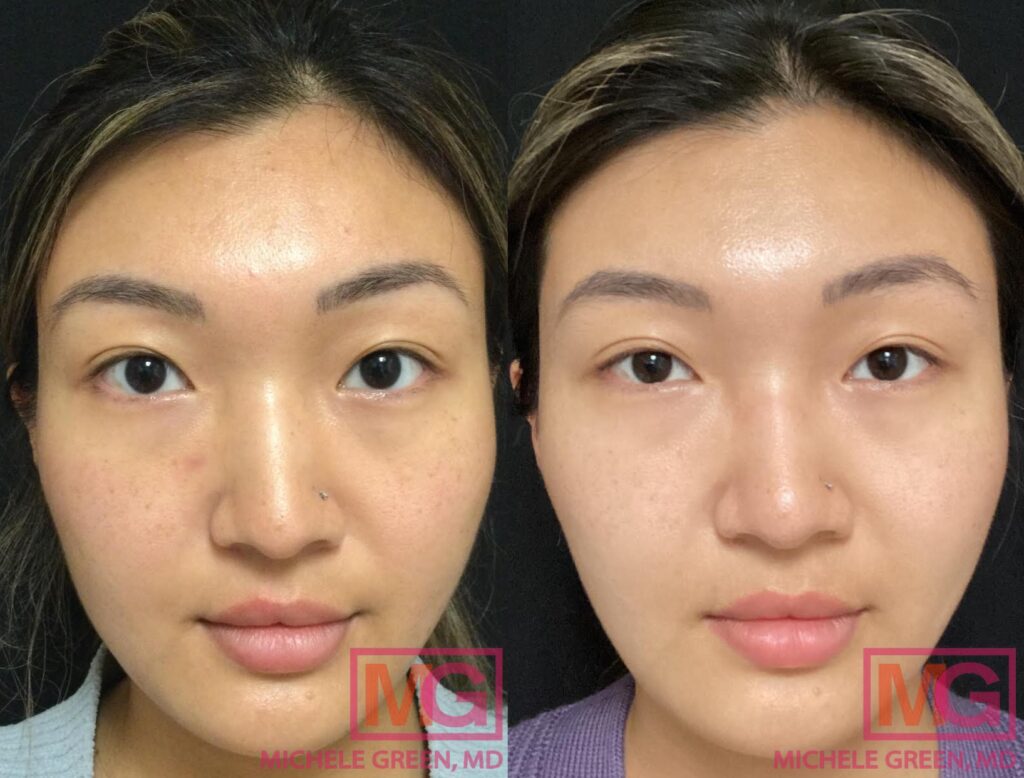
Who does Botox for TMJ Disorders?
When it comes to choosing a provider to perform your Botox injections for TMJ treatment, it is always recommended to seek an experienced board-certified dermatologist, like Dr. Michele Green, in New York City. A facial plastic surgeon, dentist, and nurse injector are all healthcare professionals who may also offer Botox injections for TMJ. A board-certified cosmetic dermatologist, however, not only has extensive medical knowledge of facial muscles involved with TMJ but also takes into great consideration the cosmetic effects of Botox and the patient’s aesthetic goals. When you consult with Dr. Green at her private dermatology office in the Upper East Side, she will work with you to customize your Botox treatment plan so that it is best suited to address your needs and achieve your ideal results.
Where do I get Botox for TMJ Treatment?
These days, Botox injections are offered in many different settings. Taking advantage of a Groupon for Botox treatment found online at a spa or facial esthetic facility for Botox injections can be tempting. However, due to the precision required for achieving optimal results from Botox injections, it is best to seek Botox treatment from an experienced board-certified dermatologist, such as Dr. Michele Green in New York City. The risk of developing severe side effects from the treatment is greatly reduced if you seek treatment from an expert dermatologist with comprehensive knowledge regarding facial anatomy and the art of masterful Botox injections. Dr. Green was among the first dermatologists in New York to offer cosmetic Botox injections, and she is an internationally renowned expert in Botox treatments for the reduction of the symptoms of TMJ.
How to get started with Botox Treatment for TMJ today?
Jaw tension and pain associated with temporomandibular joint disorders can significantly negatively impact one’s overall quality of life. Botox treatment for TMJ can relieve facial pain, reduce migraines and the soreness of jaw muscles, and minimize other TMJ symptoms. Additionally, by reducing the masseter muscles, TMJ Botox treatment can produce a facial slimming effect and create a more V-shaped jawline that many find desirable. If you are seeking a non-invasive treatment option for TMJ or interested in Botox injections in the masseter muscles for cosmetic facial slimming, Dr. Michele Green in NYC can help.
Dr. Green is an internationally renowned board-certified dermatologist with over two and a half decades of experience providing some of the world’s most discerning individuals with the best non-invasive treatment options, including TMJ Botox. Dr. Green was among the first dermatologists in NYC to offer Botox injections. She has been expertly performing what’s been described as the “best Botox treatments” in New York at her private dermatology office in the Upper East Side of Manhattan for decades. She is consistently voted one of the best physicians in New York City by Castle Connolly, the New York Times, Super Doctors, and New York Magazine for her dedication to her patients and expertise. Embracing a less-is-more philosophy and taking a holistic approach regarding rejuvenation, Dr. Green customizes each patient’s treatment plan to address their specific concerns and achieve their personal aesthetic goals. To schedule a consultation with Dr. Green and get started with your personalized Botox treatment today, contact us online or call the NYC office at 212-535-3088.
 212-535-3088
212-535-3088